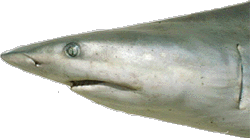
 Mini-Bull Sharks - AKA Sand Shark and Finetooth Shark
Mini-Bull Sharks - AKA Sand Shark and Finetooth Shark
Carcharhinis isodon
They range the warmer waters of the east coast. They are less excitable swiming more slowly and tend to have an aggressive look and behavior. They are a REAL shark unlike dogfishes and leopards. However, they seem to get along fine with most any other shark or ray (feed rays separate from the sharks or feed the sharks first. Rays will lose the competition or be bitten by accident.). We have kept them with rays, Sharpnose, Bonnetheads, other Mini-Bulls and even fish. Their teeth do not get so large as to do major damage to their large tank mates. This makes them ideal for systems with multiple sharks. They deliver the ultimate predatory shark look for the lowest price for a requiem shark. They have terrific girth and maintain a good healthy weight despite their small size. This makes for a pup that looks like an adult. NO MORE SKINNY sharks. Own a Mini-Bull!
They are born a very large and robust pup for their maximum size being only around 5 feet in length. Unlike other species that pup lean and tiny sharks, these shark pups are miniatures of their adult form with a thick tail at the caudal peduncle.
They will eat fish, shrimp and other foods in an aquarium. They generally do not bite humans despite their ability to deliver a serious bite as adults. Their docility in captivity should not lull the aquarist into an unwarranted and false sense of security. This can result in a serious bite. Do not handle this species. Get it into the tank using a bag or sling. Use a long dip net or sling to collect and transfer it.
REMEMBER WHEN HANDLING SHARKS: In handling this species wear heavy thick leather or Kevlar gloves. This will not protect from a puncture wound every time, but, will prevent a slashing wound. Puncture wounds are not terrible and heal quickly if treated properly immediately to prevent infection.


